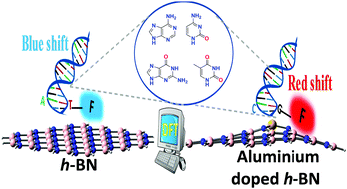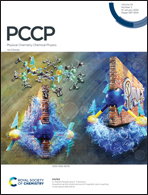Exploiting the optical sensing of fluorophore-tagged DNA nucleobases on hexagonal BN and Al-doped BN sheets: a computational study†
Abstract
Hexagonal boron nitride (h-BN) sheets possess high fluorescence quenching ability and high affinity towards DNA/RNA, and they can be used as a sensing platform for rapid detection. We report the absorption and emission properties of DNA nucleobases such as adenine (A), cytosine (C), guanine (G), and thymine (T) tagged with benzoxazole on h-BN and aluminium-doped h-BN (Al_hBN) sheets. The binding affinity of studied nucleobases on h-BN sheets at the M062X/6-31G* level of theory showed the following adsorption trend: G ≥ T ≥ A > C, which is in good agreement with the previous results. The calculated stability trend of nucleobases on the Al_hBN sheet follows as C > G > A > T at the same level of theory. The physically adsorbed behavior of nucleobases to h-BN sheets was confirmed by the non-covalent interactions (NCIs) and the total density of states (TDOS) plots. The NCI results indicated that van der Waals interactions contribute significantly to the adsorption of nucleobases on h-BN sheets. Atoms in molecules (AIM) calculations revealed the electrostatic interactions between nucleobases and the Al_hBN sheet. The quenching phenomenon of nucleobase-tagged fluorophores on h-BN and Al_hBN sheets was investigated by TD-DFT calculations using the same level of theory. The thymine-tagged fluorophore upon adsorption to the pristine h-BN sheet was found to be blue-shifted (∼43 nm); however, the guanine-tagged fluorophore with Al_hBN showed a remarkable difference from other nucleobase-tagged fluorophores in the absorption and emission spectrum. Guanine-tagged fluorophores showed a smaller blue shift (∼7 nm) in the absorption spectrum; however, it showed a larger red shift (∼55 nm) than the other nucleobase-tagged fluorophores on Al_hBN sheets and can be useful in recognizing a sequence-specific phenomenon as a fluorescent biosensor of DNA and RNA to ascertain the presence of such nucleobases.



 Please wait while we load your content...
Please wait while we load your content...